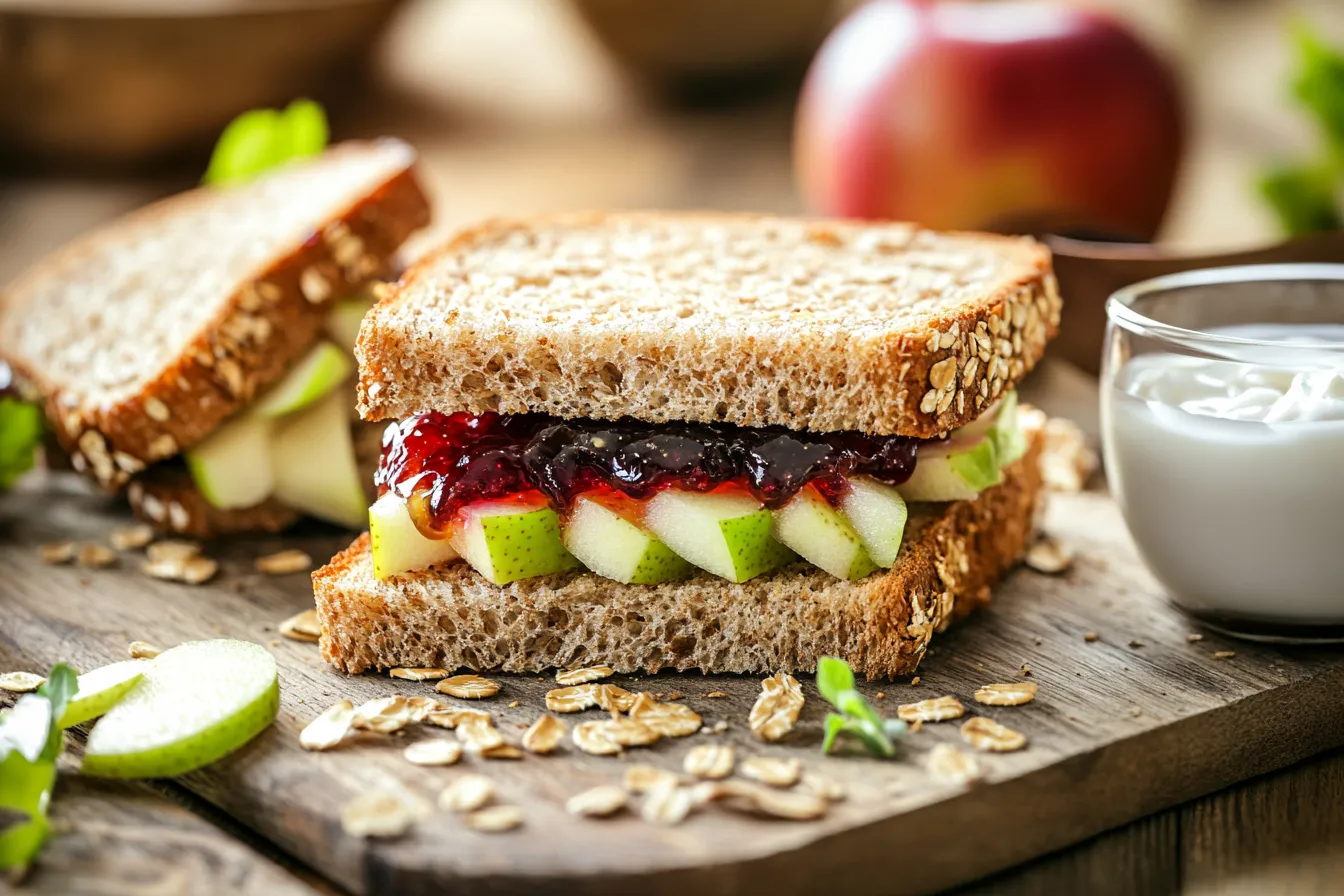Introduction
If you’ve ever wondered how many calories are in a jelly sandwich, you’re not alone. This simple, sweet, and comforting snack has been a staple for generations, especially among kids and busy adults who need a quick bite. But as more people pay attention to their nutrition, knowing exactly how many calories you’re consuming is essential. In this comprehensive guide, we’ll break down the calorie content of a jelly sandwich piece by piece — from the bread to the jelly, and even common extras like butter or peanut butter. You’ll also learn how to make healthier choices without sacrificing taste. Whether you’re tracking your macros, managing weight, or just plain curious, this article will equip you with everything you need to know about jelly sandwich calories. Let’s dive in!
What Exactly Is a Jelly Sandwich? (Definition & Components)
A jelly sandwich is as simple as it sounds: two slices of bread with a sweet fruit-based spread in between. But there’s more to it than meets the eye. Depending on the ingredients, calories can swing quite dramatically. Let’s look closely at what actually goes into a classic jelly sandwich..Knob Sandwich
What Qualifies as “Jelly”? (Jam, Preserves, Fruit Spread)
While “jelly” is the most common term, many people also use jam, preserves, or even fruit spreads. Jelly generally refers to a clear, sweet spread made from fruit juice, while jam includes mashed fruit pulp, and preserves often have whole fruit pieces. Fruit spreads may use less sugar or artificial sweeteners. Each of these choices affects the calorie count. For example, a tablespoon of classic grape jelly has around 50 calories, whereas sugar-free options can be as low as 10–15 calories. Always check the label for accurate counts, as sugar and added ingredients can vary dramatically between brands.
Bread Types (White, Whole Wheat, Multigrain)
The second core component of your jelly sandwich is bread. While white bread is the classic base, many people use whole wheat or multigrain bread for added fiber and nutrients. Here’s a quick calorie reference:
- White bread (per slice): ~70–80 calories
- Whole wheat bread (per slice): ~80–90 calories
- Multigrain bread (per slice): ~90–100 calories
With two slices, you’re usually starting with at least 140–200 calories just from bread alone. It’s easy to see how the bread choice makes a big difference in your jelly sandwich’s calorie count.
Optional Extras (Butter, Margarine, Peanut Butter)
Although a basic jelly sandwich uses only jelly and bread, many people like to add a layer of butter, margarine, or even peanut butter. This addition can significantly increase calorie content:
- Butter (1 tsp): ~35 calories
- Margarine (1 tsp): ~30 calories
- Peanut butter (1 tbsp): ~90–100 calories
Adding peanut butter, in particular, transforms your jelly sandwich into a PB&J, which is delicious but far more calorie-dense.
If you’re looking to keep things lighter, skip the butter or margarine altogether, or opt for low-fat spreads. This simple choice can shave off dozens of calories without dramatically changing the flavor or texture.
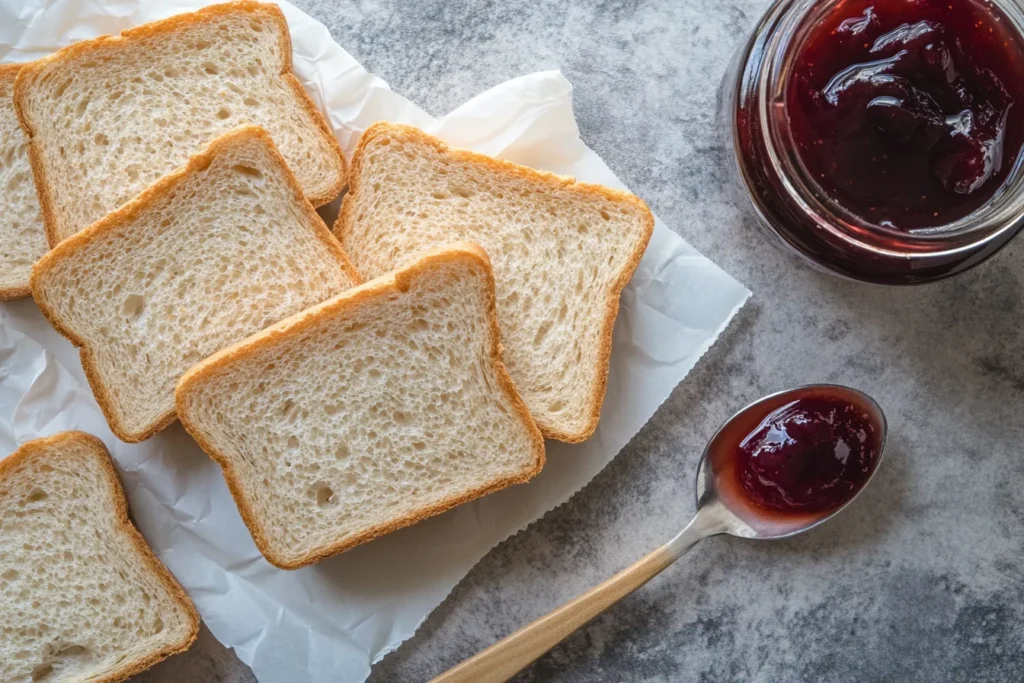
Calorie Breakdown: Component by Component
Understanding how many calories are in a jelly sandwich comes down to adding up each ingredient. Let’s break down every element in detail so you can make informed choices..Chicken Salad Sandwich
Bread Calories (per Slice, by Type)
Bread is the backbone of any sandwich, and its calorie contribution is significant. Let’s explore popular options:
- White bread: Around 70–80 calories per slice. Soft and fluffy, it’s the classic pick but has fewer nutrients and less fiber compared to whole grain.
- Whole wheat bread: 80–90 calories per slice. It provides more fiber, vitamins, and minerals, helping you stay fuller longer.
- Multigrain bread: 90–100 calories per slice. Often higher in fiber and nutrients, but sometimes made with refined grains, so check the ingredient list.
Two slices will usually total between 140–200 calories. For a lighter option, you might consider using “thin-sliced” bread varieties, which can have only 40–50 calories per slice, effectively cutting the sandwich calories in half.
Jelly/Jam Calories (per Tablespoon, by Type)
Jelly is what gives the sandwich its signature sweetness, but it can be surprisingly high in sugar. Here’s what you should know:
- Regular jelly: ~50 calories per tablespoon
- Reduced-sugar jelly: ~20–30 calories per tablespoon
- Sugar-free jelly: ~10–15 calories per tablespoon
Most people spread around 1–2 tablespoons on their sandwich, so the jelly alone can add 50–100 calories if you’re using the regular kind. If you’re concerned about sugar spikes or extra calories, switching to a low-sugar or sugar-free spread can make a meaningful difference.
Butter/Margarine and Peanut Butter Additions
While a pure jelly sandwich is usually bread + jelly, many people enjoy a swipe of butter or peanut butter for extra richness:
- Butter: 1 teaspoon = ~35 calories
- Margarine: 1 teaspoon = ~30 calories
- Peanut butter: 1 tablespoon = ~90–100 calories
Adding peanut butter essentially turns the sandwich into a peanut butter and jelly (PB&J) version, dramatically increasing the calorie count. A standard PB&J can run from 350–450 calories depending on bread, spread, and add-ons.
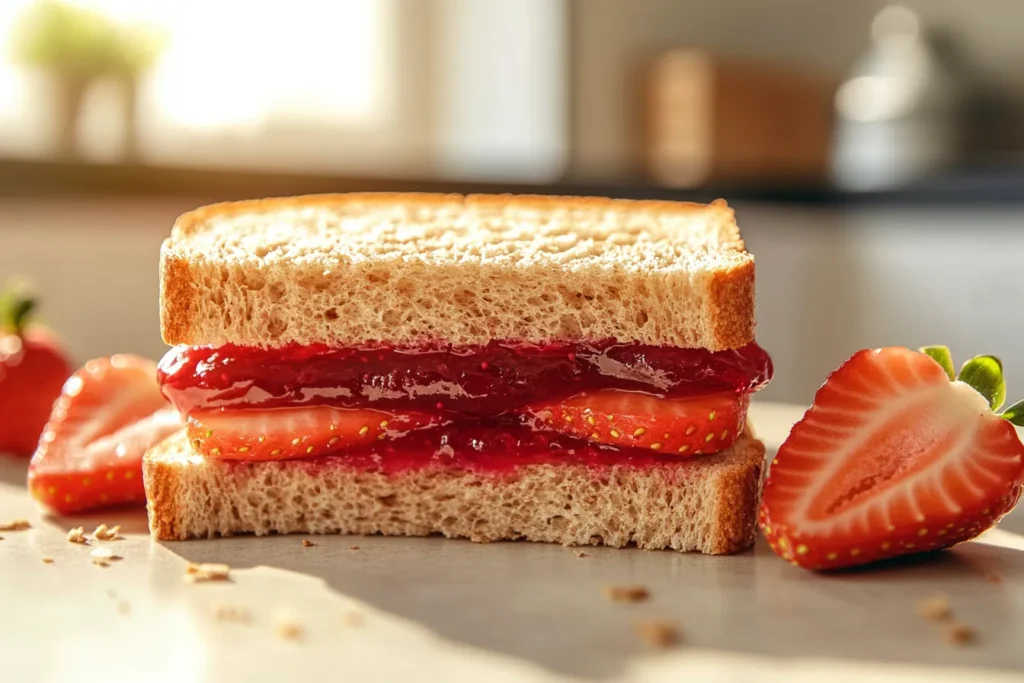
How Many Calories in a Standard Jelly Sandwich?
So, what is the grand total for a “classic” jelly sandwich made with two slices of white bread and 1 tablespoon of jelly? Let’s add it up:
- Bread (white): 140–160 calories (2 slices)
- Jelly (regular, 1 tbsp): 50 calories
Total: around 190–210 calories
If you use whole wheat bread and two tablespoons of jelly, the total may be closer to 250 calories. Remember, if you add butter or peanut butter, those numbers will rise quickly.
Variations: Whole Wheat, Multigrain, Low‑Sugar Jelly
By swapping ingredients, you can modify your jelly sandwich’s calorie load:
- Whole wheat bread + sugar-free jelly: ~170 calories
- Multigrain bread + reduced-sugar jelly: ~200 calories
- Thin-sliced bread + sugar-free jelly: ~120–150 calories
As you can see, small changes can have a big impact on your calorie intake without sacrificing taste.
Health Implications of a Jelly Sandwich
While a jelly sandwich is quick, tasty, and convenient, it’s worth considering its impact on your health. Calories are just one piece of the puzzle — the sugar content, fiber levels, and nutritional quality all matter too. Let’s dig deeper.
Sugar Content and Glycemic Impact
One of the biggest concerns with a jelly sandwich is its sugar content. Regular jelly is typically loaded with refined sugars, which can cause a rapid spike in blood glucose. For people with diabetes or those watching their sugar intake, that can be a problem. Two tablespoons of regular jelly can pack up to 20 grams of sugar — nearly half the recommended daily limit for added sugars.
That sugar surge can lead to a “crash” in energy later, leaving you hungry again soon. This is why many nutritionists recommend choosing reduced-sugar or sugar-free spreads, which can dramatically lower the glycemic impact of your sandwich. Pairing jelly with a high-fiber bread can also help slow down digestion and stabilize blood sugar.
Fiber and Nutritional Pros/Cons
Bread choice makes a big difference in the nutritional profile of your jelly sandwich. Whole wheat and multigrain breads contain more fiber, which supports gut health and helps you feel full longer. Fiber also slows sugar absorption, keeping your energy levels steadier.
On the downside, if you choose refined white bread and sugary jelly, you’re essentially eating a high-carb, low-nutrient meal. It might satisfy your sweet tooth, but it won’t provide much else in terms of protein, vitamins, or healthy fats.
Recommended Portion Sizes and Alternatives
Portion control is key if you’re watching calories. A full-size jelly sandwich can land in the 200–250 calorie range, which is reasonable as a snack or small meal. But eating several in one sitting — which is easy to do because they’re tasty and convenient — can stack up calories fast.
Here are a few smart alternatives to keep calories in check:
- Make an open-faced jelly sandwich with just one slice of bread.
- Use thin-sliced bread to cut calories in half.
- Spread less jelly or opt for a sugar-free variety.
- Add a tablespoon of peanut butter to provide protein and healthy fats, which help balance out the sugars and improve satiety.
These simple strategies can help you enjoy a jelly sandwich while staying on track with your nutrition goals.
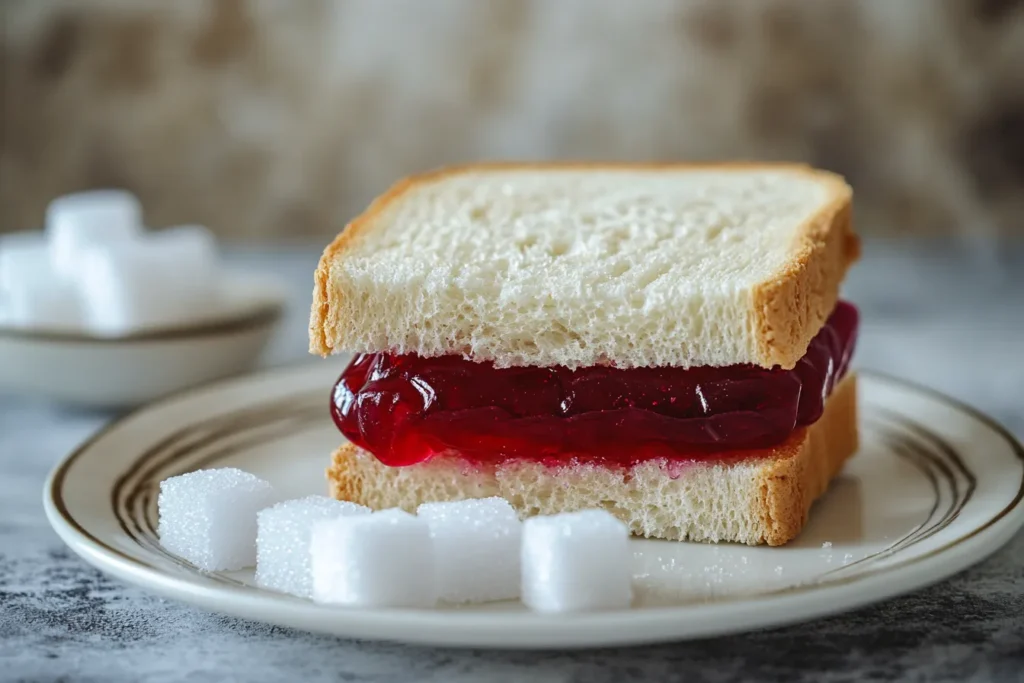
Tips to Reduce Calories Without Losing Taste
Everyone wants their food to taste good, even when eating healthier. Thankfully, there are easy ways to keep the delicious flavor of a jelly sandwich while reducing its calorie load.
Choose Low-Calorie Bread or Thin-Slice Options
Many brands now sell thin-sliced bread, which has around 40–50 calories per slice compared to 80–100 for a regular slice. That simple swap can save you 80–100 calories per sandwich while still satisfying your craving.
Use Sugar-Free or Low-Sugar Spread
Switching from traditional jelly to sugar-free or reduced-sugar options can save 30–40 calories per tablespoon — and you’ll still get the sweet, fruity taste you love. Brands like Smucker’s and Polaner offer options with no added sugar that taste remarkably close to the classic jellies.
Add Protein/Fiber (e.g., Nut Butter, Seeds)
Combining jelly with a thin layer of peanut butter, almond butter, or even chia seeds can transform your sandwich from a sugary snack to a more balanced meal. The protein and fiber slow digestion and help keep you full, preventing the blood sugar spikes that come from eating simple carbs alone.
Make Open-Faced or Half-Sandwich Options
Serving your jelly on one slice of bread instead of two can instantly cut the calories by about 70–100, depending on the bread type. If you need a bit more volume, try a half-sandwich alongside fresh fruit for a healthier, more satisfying snack.
Jelly Sandwich in Diet Plans & Weight Loss
A jelly sandwich can absolutely fit into a balanced diet, even for those focused on weight loss. The key lies in portion control, ingredient choice, and pairing it with other healthy foods. Let’s break down how to work it into your meal plan without sabotaging your goals.
Incorporating It into Calorie-Counting Plans
If you’re tracking your calories through apps like MyFitnessPal or MyNetDiary, logging a jelly sandwich is simple. Just remember to measure accurately:
- Weigh or measure your jelly (tablespoons)
- Confirm your bread type and slice size
- Don’t forget any extras (like butter or peanut butter)
With these details, you’ll get an accurate calorie snapshot to help you stay within your daily target. At roughly 190–250 calories, a jelly sandwich can serve as a sensible snack or a lighter breakfast.
Meal Timing (Breakfast/Snack)
Many people enjoy a jelly sandwich as a quick breakfast with coffee or tea. It offers a burst of quick carbohydrates that can be great for morning energy. If you have a more active lifestyle, you might also use it as a pre-workout snack because the simple sugars provide fast fuel.
However, as a lunch or dinner, it might be less ideal since it’s relatively low in protein. If you plan to eat a jelly sandwich later in the day, consider adding a protein source, such as a boiled egg, a protein shake, or even a slice of cheese on the side to balance your meal.
Pairings for Balanced Nutrition
A jelly sandwich on its own is high in carbs and sugars, which might leave you hungry again in an hour or two. Pairing it with other nutrient-rich foods can create a more satisfying, balanced meal. Consider these ideas:
- Fresh fruit for extra fiber and vitamins
- A handful of nuts for protein and healthy fat
- A low-fat yogurt to boost protein and probiotics
- Raw veggies to increase fiber and volume
This approach helps stabilize your blood sugar and keeps you fuller longer, making your jelly sandwich part of a well-rounded, healthy eating plan.
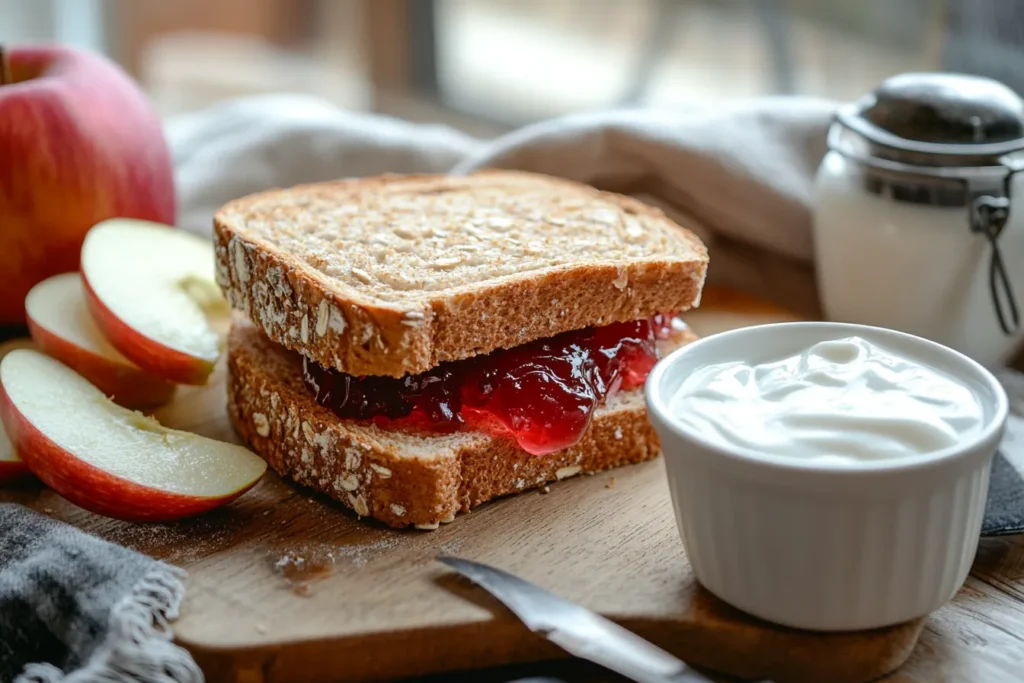
Jelly Sandwich vs Other Sandwiches: A Calorie Comparison
You might be wondering how a plain jelly sandwich stacks up against other popular sandwich options. Let’s compare them side by side to give you perspective.
PB&J vs Jelly-Only
A peanut butter and jelly sandwich (PB&J) is much more calorie-dense than a jelly-only version. The average PB&J can clock in at 350–450 calories, while a jelly-only sandwich usually falls around 190–250 calories. Peanut butter is calorie-rich but does offer more protein and healthy fat, making it a better choice for lasting energy if you can fit it into your daily budget.
Nut Butter + Jelly + Banana
Adding banana slices to a PB&J is a classic twist, but it raises calories even more. Depending on how thick you slice the banana, this combination can go up to 450–500 calories. While delicious, it’s best enjoyed occasionally, especially if you’re keeping an eye on your calorie goals.
Grilled Jelly Sandwich (Add Butter, Grill)
Grilling a jelly sandwich with butter is another tasty spin, but it pushes calories higher fast. Adding just one tablespoon of butter (about 100 calories) plus frying the bread can increase the total to 300–400 calories. It’s delicious, but something to have in moderation if you’re aiming for lower-calorie meals.
Frequently Asked Questions
Let’s tackle some of the most common questions people have about jelly sandwiches and their calorie content. These quick answers will help you make even more informed decisions.
Is a Jelly Sandwich Fattening?
A jelly sandwich on its own is not inherently fattening. Like any food, it depends on portion size and frequency. If you eat a jelly sandwich occasionally, and it fits within your calorie needs, it’s absolutely fine. But eating several jelly sandwiches daily, especially with high-sugar jelly and white bread, can contribute to weight gain over time because of the simple carbs and added sugars.
Can I Lose Weight Eating Jelly Sandwiches?
Yes, you can lose weight while including jelly sandwiches in your diet — the key is moderation and balance. As long as you stay within your calorie limits and include nutritious, protein-rich foods in other meals, there is no reason you can’t enjoy a jelly sandwich from time to time. Try healthier tweaks, like whole wheat bread and sugar-free jelly, to make it more weight-loss friendly.
Which Breads Are Lowest Calorie?
Thin-sliced white or wheat bread is typically the lowest in calories, with around 40–50 calories per slice. Traditional white or whole wheat bread usually ranges between 70–100 calories per slice. You can also explore low-carb breads, which often have fewer calories but more fiber and protein.
Are There Healthier Spreads Than Jelly?
Absolutely! There are many alternatives to classic jelly:
- Sugar-free or reduced-sugar fruit spreads
- Nut butters (peanut, almond, cashew) with no added sugar
- Mashed fruit, like bananas or strawberries, as a natural spread
- Even hummus or avocado, though savory, can replace jelly for a creative twist
How Many Calories if I Add Peanut Butter?
If you add one tablespoon of peanut butter, expect to add about 90–100 calories. A peanut butter and jelly sandwich on two slices of white bread with one tablespoon of jelly typically comes to about 350–400 calories.
Is Homemade Jam Better Than Store-Bought?
Homemade jam can be a healthier option because you can control the sugar content and avoid additives or preservatives found in many store-bought brands. Homemade jams made with less sugar and more real fruit are typically lower in calories and higher in nutrients, but always measure out your portions since even homemade options contain natural sugars.
Conclusion
A jelly sandwich remains a nostalgic, easy, and delicious treat for many people. Calorie-wise, a basic jelly sandwich made with white bread and standard jelly generally comes in around 190–250 calories. By choosing whole wheat or multigrain bread, sugar-free jelly, or thin-sliced bread, you can easily lighten the calorie load without sacrificing the sweet flavor you love.
Remember, there is no reason to fear a jelly sandwich — just be mindful of portion sizes and consider pairing it with protein or fiber-rich sides to balance your meal. Whether you enjoy it as a quick breakfast, a midday snack, or even a pre-workout bite, it can have a place in a healthy lifestyle.
If you’d like to explore more calorie details, you can also check out resources like MyNetDiary’s calorie tracker, or consult USDA FoodData Central for the most accurate nutritional data. And for a practical look at healthier spreads, check out Harvard’s Healthy Eating Plate for further ideas.
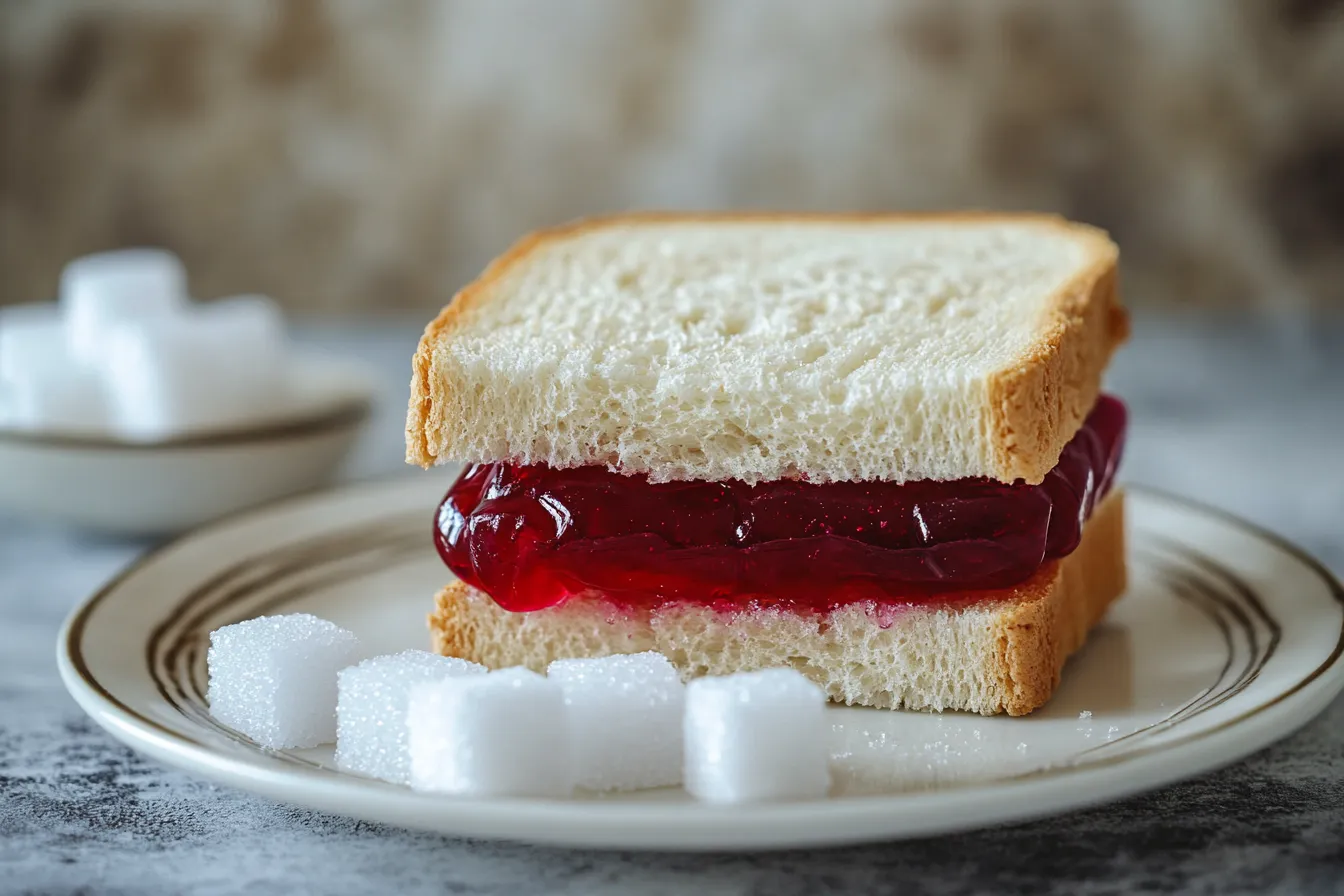
Name: Classic Jelly Sandwich
Ingredients
Equipment
Method
- Instructions:
- Place two slices of bread on a plate.
- Spread the jelly evenly across one slice using a butter knife.
- Top with the second slice of bread.
- Cut in half if desired, and serve.

